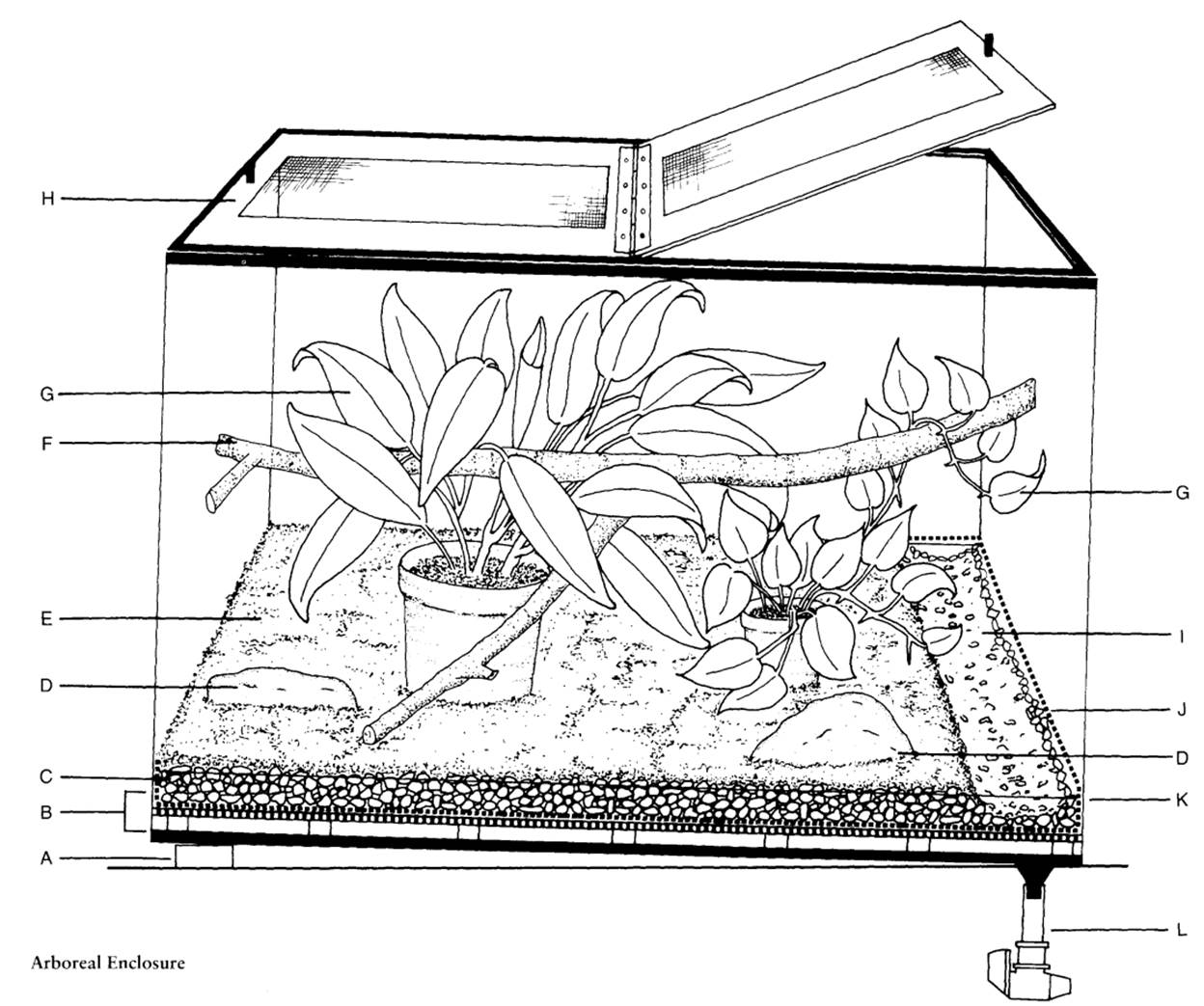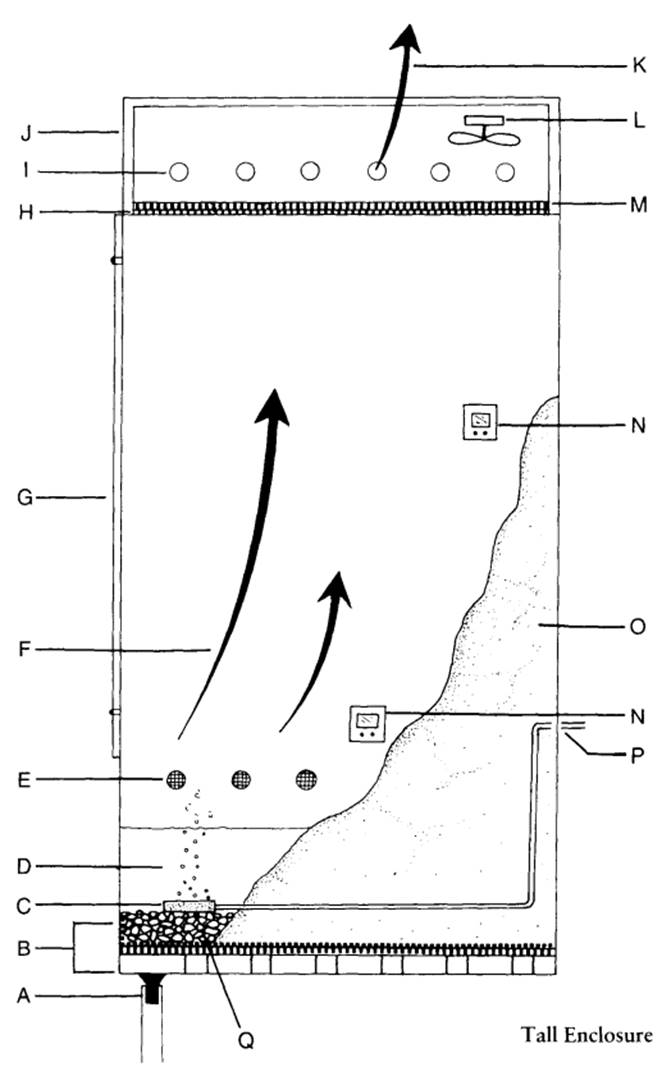Arboreal Enclosure for Amphibians
Complex Arboreal Enclosure. The basic design for a terrestrial forest floor vivarium is appropriate for arboreal amphibians, although the arboreal enclosure should be as tall as possible and provided with tall plants and branches. Hexagonal aquariums that are especially suitable for this purpose are available in a variety of sizes.
Arboreal enclosures can be very complex, taking on the appearance of a richly stratified forest, with branches covered with mosses and epiphytic plants, terrestrial vegetation, and a pool. The back and side walls may be covered with sheets of cork bark or tropical fern fiber and planted with more epiphytic vegetation, or climbing vines. Wall growth is encouraged by trickling water down the wall with a recirculating pump, powerhead, or canister filter.
A much simpler enclosure that still satisfies the needs of arboreal anurans has been successfully used for years at the National Aquarium in Baltimore (Plate 5.5, Figures 5.8, 5.9). It consists of a gravel substrate overlaid by moist sheet moss. One or two large potted plants, usually a broad-leaved species of Agleonema, are partially buried in the gravel. The plants fill out most of the open vertical space in the enclosure. One or two hardwood branches, with a strong horizontal inclination, provide arboreal perches for the amphibians, but some vertically inclined branches should be also available. On the floor of the cage, there is a pool or shallow water bowl. A small golden pothos, Epipremnum aureum, or peace lily, Spathiphyllum sp., may be planted next to the water to provide cover for the animals. The water section of the arboreal vivarium is not deep. A water depth of 2.5 cm (1 in) is adequate.

Figure 5.8. Lateral view of arboreal enclosure for amphibians. A. cross-section of board supporting the rim of the tank, tipping it toward the drain. B. false floor assembly (see Figure 5.1 В—D). C. pea gravel layer approximately 2.5-5 cm (1 to 2”) thick. D. rock perch. E. moist sheet moss. F. cut hardwood branch or sturdy vine with no sharp edges or points. G. live, potted plant with the base of the pot resting on the fiberglass screen. H. lid (see Figure 5.1 E—H). I. shallow pool. J. upturned edge of fiberglass floor screen; it provides an escape route for food insects that fall into the pool and swim or drift to the glass wall. K. water level. L. drain assembly (see Figure 5.1 К—M). (Sandy Barnett)

Figure 5.9. Lateral view of a tall enclosure for arboreal amphibians showing appropriate air circulation patterns (after Stettler, 1981). Even tall vivariums can ventiliate well with proper placement of ventilation holes/panels to create cross air currents. A. drain. B. false floor assembly (see Figure 5.1 В—D). C. air stone connected to an outside aquarium air pump. D. pool. E. screened ventilation holes in one wall of enclosure, at a low level (alternatively, an aquarium air pump can be used to add fresh air low in the enclosure). F. warm, moist air rising from the heated water or land mass (e.g. heated by a submersible aquarium heater, undertank heating pad or tape, or buried heating cable). G. front of the enclosure with a sliding or hinged access door. H. screened ceiling. I. ventilation holes in the vivarium hood for warm air to escape. J. vivarium hood holding fluorescent and spot lights. K. vented air. L. small venting fan inside hood. M. white egg-crate screening to reduce glare from overhead lights. N. hygrometer/thermometer. O. land mass. P. hole in wall for electrical and air lines. Q. pea gravel. (Sandy Barnett)
Broad-leaved plants should be used if leaf-spawning anurans are to be housed in the enclosure. Since some anurans oviposit on leaves that overhang water, care must be taken to locate plants near the water’s edge.
Some arboreal anurans (e.g. the hourglass treefrog, Hyla ebraccata, and the orange-sided leaf treefrog, Phyllomedusa hypochondrialis) readily sleep on the smooth inside wall of retreats made from dark plastic containers. While such refuges are not particularly attractive, they make it quick and easy to inventory and monitor frogs that might otherwise be difficult to find during their sleep period.
Cliffside Arboreal Enclosure. Many crevice dwelling amphibians, such as the green salamander, Aneides aeneus, and some of the slender salamanders, Batrachoseps spp., are not arboreal, and do best in a tall enclosure with high rock faces rather than cork or other plant material. The rocks should be securely fixed together with silicon rubber or a waterproof nontoxic epoxy, and stacked in such a way that there are a variety of crevices to serve as retreats. A slight trickle down one face of the rock surface will create a moisture gradient that may encourage breeding in those areas (similar to conditions in the wild).
Spartan Arboreal Enclosure. A spartan version of the arboreal terrarium has been used successfully at the Philadelphia Zoo to house some species of amphibians during quarantine and for the duration of certain medical treatments. The tank floor is covered with moist paper toweling. Enrichment is limited to a water bowl and strips of mylar plastic or plastic plants draped down the walls. The amphibians can hide behind the plastic strips or plastic plants, clinging to the walls or plastic. A dark strip of plastic is hung on the outside of one wall of the enclosure to block the light. Breeding of the New Granada cross-banded frog, Smilisca phaeota, occurred in such an enclosure.
Date added: 2025-02-17; views: 378;
